The digestive tract in ruminants and methane production
Fermentation, the process in which complex cellulose material is digested and broken down, occurs within the rumen. This fermentation process is facilitated by the presence of the rumen microbiome, consisting of protozoa, bacteria, fungi and archaea. In the process of fermentation, these microorganisms will break down cellulose material by hydrolysis into volatile fatty acids (VFA): mainly acetate, propionate and butyrate (Fig.1). Apart from VFAs, different quantities of formic acid, hydrogen (H2) and carbon dioxide (CO2) are produced as well (Hook et al., 2010).

- Adapted from NAgaraja, T.G.C.J.x, Newbold, C.J. Van Nevel & D.I. Meyer. 1987. Manipulation of Rumen Fermentation. The Rumen Microbial Ecosystem 2nd Edition. Ed: Hobson & Stewart. Pp. 538 – 547
Methane production in the rumen
Methane is produced from carbon dioxide and hydrogen. The production of methane varies between individual animals, regardless of the fact that they have been fed the same feed. Ruminants can produce 250 to 500 litres of methane per day.
This methane is not an energy source. It will not be used by the animal itself, but rather released through eructation, representing an energy loss (Fig.1) of 2 – 12% of gross energy (Johnson and Johnson, 1995).
The ratio between VFAs produced in the rumen will greatly influence the overall methane production. There are different outcomes in metabolism of volatile fatty acids in the rumen. In the production of acetate, CO2 is released. It carries a carbon molecule which methanogenic archaea can utilize for the production of methane. Similar process occurs with butyrate, since when two molecules of acetate are combined, butyrate is produced. Propionate, on the other hand, is the only VFA that doesn’t release a carbon molecule.
The release of carbon will consequently influence VFA energy values in favour of propionate, resulting in ratio of around 109% for propionate, 78% for butyrate and 62% for acetate. In conclusion, increasing the amount of propionate will decrease methane production and increase animal performance (Luebbe, 2014).
Control of methane emissions
The control of methane emissions from cattle is increasing in importance because of their contribution to greenhouse gases. Various strategies, including different diets containing high concentrations of lipids or the inclusion of plant compounds such as tannins, enzymes and ionophores have been implemented (Beauchemin et al., 2009; Hook et al., 2010; Cieslak et al., 2013) in order to reduce methane emissions from cattle.
The influence of Monovet® 200 on rumen microflora
Monovet® 200 is a microgranulated premix (Fig.2), containing monensin as the active ingredient. It is produced by Huvepharma® in a completely integrated process, under the highest quality standards, complying with both EU (EMEA) as well as US (FDA) regulations. Monensin belongs to the group of carboxylic ionophores produced by Streptomyces cinnamonensis and is not used in human medicine. Monovet® 200 is composed of the monensin analogues A, B, C and D with monensin A being the major component. It has antimicrobial as well as anticoccidial properties.
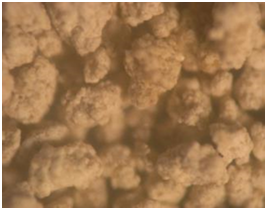
Because Monovet® 200 has both antimicrobial and anticoccidial properties, it can be used in all stages of cattle production for different purposes.
It has proven to be beneficial in the treatment of coccidiosis in calves and for the modification of rumen microflora in functional, adult ruminants. Monensin inhibits the growth and function of certain types of bacteria. In the rumen, it targets bacteria producing acetate and consequently the production of butyrate, two out of the three most commonly-produced VFAs. As a result, propionate-producing bacteria are favored. This mechanism allows for a better energy output which can be used to increase animal performance as well as for improving production results, justifying the use of Monovet® 200 as a growth promotor. At the same time, Monovet® 200 reduces the production of waste gasses including methane. Since acetate and butyrate are also the precursors of ketone bodies, Monovet® 200 can be used for control and prevention of ketosis.
Published trial data on the influence of monensin on methane production in cattle
Trial 1
A trial was set up to investigate the in vivo influence of monensin on methane gas emissions. In the trial, urea molasses in a mineral block (UMMB) enriched with monensin were given to calves (Debasis et al, 2012). Four crossbreed calves were allocated to four groups, in a switchover design consisting of 4 treatments 4 animals and 4 periods. The trial lasted for 23 days including a 15 day adaptation period. This was followed by 3 days of a gas collection period and 5 days of a digestibility trial.
Group 1 received concentrate and wheat straw ad lib. Group 2 received the same as group 1 with an additional 30mg/d of monensin. Groups 3 and 4 received 30% less concentrate substituted through a UMMB. The UMMB in Group 4 was enriched with 100 ppm of monensin. Methane emissions (l/d) were affected significantly (P<0.01) in Group 4, followed by Group 2, Group 3 and Group 1. (Fig.3).
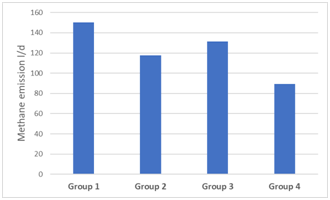
The results of the 5-day digestibility trial showed a significant (P<0.01) difference of methane emissions in l/kg of digestible dry matter intake (DDMI) and digestible organic matter intake (DOMI) and are presented in Fig.4.
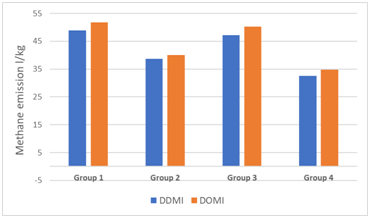
Since no significant difference was shown between groups 1 and 3, as well as between groups 2 and 4, the conclusion of this trial was that a monensin-enriched UMMB can significantly reduce methane production.
Trial 2
Trial 2 investigated the effects of dietary supplementation of monensin on nutrient digestibility and enteric methane emission in non-pregnant dry Murrah buffaloes (Gupta et al., 2018). Fourteen animals were randomly divided into two groups of seven animals (control and treatment) based on body weight. The treatment group received supplementation of 350 mg/head/d of monensin. The trial lasted 60 days. The daily nutrient intake (kg/d) and apparent digestibility (%) were similar in both groups. The enteric methane emission (g/d) was reduced significantly (P<0.05) by 10.09%: from 202.44±5.92 to 182.02±5.02 (Fig.5). The methane emission was also reduced by 6.34% for g/kg of dry matter (DM) intake from 21.12±0.18 g/kg in the control group to 19.78±0.28 g/kg (Fig.6).
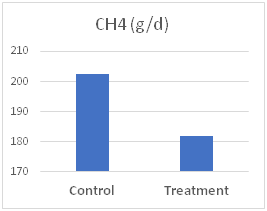
Fig.5 Enteric CH4 emission 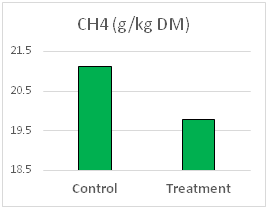
Fig.6 Methane emission on DM intake
The significant (P<0.05) reduction of energy loss in the form of methane is presented in Fig.7, as a % of gross energy (GE), digestible energy (DE) and metabolizable energy (ME) and were 6.36%, 9.24% and 9.79%, respectively.
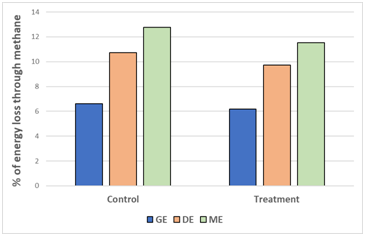
The trial concluded that dietary monensin supplementation to non-pregnant Murrah buffaloes can reduce enteric methane emissions without affecting nutrient intake and digestibility.
Trial 3
The effects of monensin supplemented in feed on nutrient utilization and enteric methane emissions were researched in Lactating Murrah Buffaloes (Gupta et al., 2018). Twelve lactating Murrah buffaloes were divided into two groups (n=6): control and treatment, based on the body weight and days in milk. Both groups were fed graze and concentrate mixture (70:30 ratio) as a total mixed ration.
Monensin was supplemented to the treatment group at a rate of 24 mg/kg of dry matter intake for sixty days. Nutrient utilization and enteric methane emissions were measured 50 days after the beginning of the monensin supplementation. The daily intake (kg/d) and apparent digestibility (%) of nutrients were similar (P>0.05) in both groups.
It was concluded that, although the number of animals in the trial was small and more long-term trials are needed, supplementation of monensin at 24 mg/kg of DMI to buffaloes had no effect on feed intake, feed digestibility and milk production but reduced the daily methane emissions by 8.55% and methane emission intensity by 13.2%, contributing to the reduction of greenhouse gasses.
Conclusion
Monovet® 200, containing monensin as an active ingredient, presents a reliable solution to reduce methane production and energy loss in cattle, regardless of the stage of production, without influencing dry matter intake or digestibility. Moreover, by modifying the rumen microflora in the direction of the production of propionate, it creates a surplus of energy that can be utilized for the improvement of production results, whilst controlling the onset of ketosis at the same time. It alsorepresents a potent tool for prevention and control of coccidiosis in calves